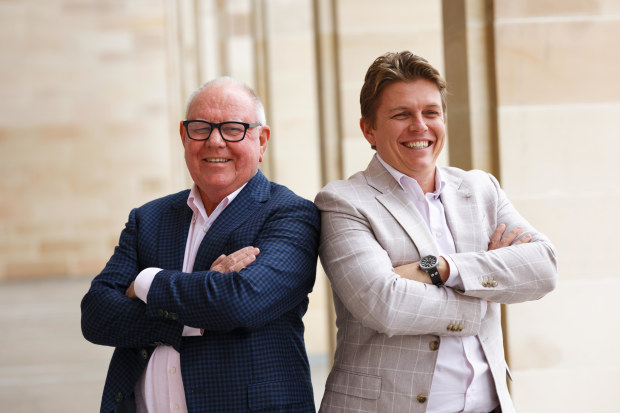Quitting McKinsey led this man to a $40m fortune Julie-anne Sprague
Julie-anne SpragueRich List editor
Oct 28, 2021 – 5.00am
Save
Share
Alex Dorsch remembers it was “very easy” quitting a promising career with consultancy firm McKinsey for a job with a little-known mining exploration company that was on a gruelling quest to strike it big.
“Don’t get me wrong, the experience at McKinsey was fantastic,” Dorsch says.
“It was great to fly around the planet and work with all these diverse clients. But you’d do this great work with these clients then walk away and never see them again.

Tim Goyder, left, and Alex Dorsch, chairman and CEO of Perth-based Chalice Mining. Trevor Collens
“You don’t get the satisfaction that you made a difference. I really wanted to be on the owner’s team. I wanted to have the responsibility and accountability so if things go well, then you can actually own something that goes well.”
Four years after making that career-altering decision, Dorsch, 34, finds himself debuting on the Financial Review Young Rich List, inside
The Australian Financial Review Magazine on Friday, with an estimated wealth of $40 million.
CHNChalice Gold Mines[/paste:font]$6.990 -0.43%
1 year1 dayOct 20Feb 21May 21Oct 212.0006.00010.000
Updated: Oct 28, 2021 – 9.55am. Data is 20 mins delayed.
View CHN related articles Advertisement
It’s a wealth pile driven by equity and options held in Chalice Mining, which has seen its share price soar from 18¢ to over $7 since Dorsch joined in late 2017.
Why? Chalice just happened to unearth Australia’s first major palladium discovery that contains high-grade nickel, copper and a range of critical “green metals”. And it’s just 70 kilometres north-east of Perth.
The little-known mining explorer is now worth $2.5 billion.
Such is its success that outgoing chairman and founder Tim Goyder is poised to join next year’s Rich List, and potentially the billionaires club, with his equity investments worth $833 million on Thursday.
Wealth balloonsGoyder, a cousin of Qantas and Woodside chairman Richard Goyder, has been in the exploring game since his early 20s and has been addicted to finding the next big thing ever since. Now at 67, he’s set to retire from the Chalice board.
Advertisement
He’s struck lightning twice. Alongside his Chalice investment, worth $260 million, he is behind the $3.5 billion lithium group Liontown Resources, with his shares worth a staggering $570 million on Thursday. At the beginning of 2020, his investments were worth a combined $36 million.
One of the biggest challenges Goyder faces is finding quality people to help grow explorers unable to offer lavish salaries as they pour capital into drilling programs.
“We had gone through various recruitment firms, and they dished up all the usual people,” he recalls when looking for a new chief executive to take over the helm. “The geologists, engineers and metallurgists. They were good but they were not really capable of seeing the bigger picture.”
A mutual acquaintance put him in touch with Dorsch and the pair went to dinner at Lamont’s, in Perth’s seaside suburb Cottesloe.
“I could paint the big picture; Alex saw the big picture,” Goyder says.
Advertisement
From sales to CEOIt didn’t hurt that Dorsch was spending about as much time out of Perth as he was in it. His job at McKinsey had him flying to Brisbane on a Sunday, returning to Perth on Thursdays. His wife was three months pregnant with their first child.
“It was a very easy decision in the end,” Dorsch says.
Initially employed as a business development manager, he was appointed chief executive within three months in March 2018, when Chalice shares were trading at 18¢. He was given an options package (4 million unlisted share options with exercise prices of 20¢ and 22¢, vesting in three tranches over a two-year time period).
“Everyone within the organisation was incentivised through some sort of equity performance-based equity package. That was a good way to motivate every person, just to give that little bit extra when you’re asking people to be on a fairly modest salary and hunt around the world for assets and opportunities.”
As well as hiring Dorsch, Goyder assembled a team with experience in nickel sulphides to branch out from its gold assets to metals fuelling the growing electric vehicle and lithium battery markets.
Advertisement
Discoveries are hard to come by. There was the Nova-Bollinger find in 2012, followed by
Cosmos in 1997. Both are in WA.
“They are 10 years between drinks globally, so we thought where is the world going to get all this nickel from?”
They tried and failed to buy an asset in North America.
Pot of goldThen a young French geologist spent some time on weekends taking a look at an overlooked and unloved area just 1.5 hours from Perth.
“It’s just up the road. Everyone has just driven by it. That’s the thing about geologists. They are always biased to where there is already metal,” Dorsch says. “So they go and look for nickel in Kambalda or go find iron ore in the Pilbara. There’s only a small number of geologists who think outside the box.”
Advertisement
They set aside $70,000 to have a look around, just a fraction of the $5 million or so ploughed into other exploration activities. The early work was looking promising. They organised a drill rig. On the second day of drilling, they struck the proverbial pot of gold.
It was early March 2020, and a panicked nation was being forced to work from home while other businesses were being forced shut as COVID-19 washed ashore. Dorsch’s second baby had just been born. And then his world shifted even more.
The geologists found something. On March 23, two years to the day of Mr Dorsch’s appointment as CEO and as the Australian sharemarket crashed to its pandemic low, Chalice told the market the company had struck high-grade nickel, copper and palladium sulphide.
“The geologists were in disbelief,” Dorsch remembers. “Normally you have to go 200 to 300 metres below the surface to see that kind of material. We got high-grade mineralisation at 30 metres. It was so shallow, and it was beautifully preserved.”
Shares surgeThey rushed to peg more land around their initial project.
Advertisement
“We think we have hit the first major one [deposit] but if you look at how mineral provinces unravel, it takes one big one and then after 5-10 years you get big new discoveries made [nearby]. It doesn’t always happen. It doesn’t always repeat but we are hoping we can unlock a couple more in the next few years.“
Just three years ago, Dorsch remembers dreaming about lifting the company’s shares to 50¢.
“We would say if we can just get this thing to 50¢ or 60¢, wouldn’t that be great?” He said no one back then thought it would fire beyond $7 a share.
“I did!” exclaims Goyder, who’s been in the mining game since his early 20s. Some of his first deals were with the prospectors Lang Hancock and Peter Wright.
But it was founding Chalice and Liontown, both floated at 20¢ a share in 2006, that has finally delivered the spoils.
“It’s only taken 16 years,” he adds. “It takes a lot to make it. You need a damn good board and a good team behind you.”
 (20min delay)
(20min delay)









